On a Saturday that began with thunderstorms and flash flood warnings throughout Chicago, Lucky Plush Productions offered the chance to walk around the city and enjoy some of Chicago’s notable performance venues—albeit virtually. Using the platform Gather.Town, Lucky Plush created a one-weekend mini-festival June 25-26, celebrating Chicago’s performance scene through venues like the Harris Theater, Links Hall, Logan Center for the Arts, and Steppenwolf Theatre Company. Titled The Map of Now, the virtual experience provided audiences with a simplified map of the city in which avatars could explore various venues and performances. It was a bit reminiscent of how early generations of Pokémon games felt, minus the tall grass or the chance to catch ’em all, and with the big plus that anyone you passed on your journey could interact with you via webcam.
When I first clicked onto Gather.Town, after creating my little avatar and stepping through the tutorial, I was pleasantly surprised by how large the map actually was. I had come expecting to spend about two hours in this virtual world, but suddenly, pulling up the map made me worry that I’d be able to accomplish all I wanted to in that window. While The Map of Now provided “buses” that would instantly transport you to venues if your avatar stepped on to them, I chose to walk the map instead. In hindsight, I might have been better off taking the bus, since I got distracted a couple times while looking at the handful of virtual games laid out around the map.
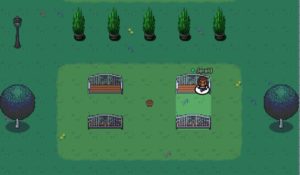
The whole point of Gather.Town is that your webcam is always on, allowing you to see other peoples’ faces when you walk your avatar close to them and have spontaneous conversations. Or, if you’re virtually attending with a group, you can find private seating areas where you can have siloed conversations, demarcated by boxes around groups of seats, or even play games like Codewords or the Mafia-like game Werewolf. When I happened to stumble onto a game of Tetris, of course I had to give it a go on my way to my first virtual “performance.”
A note for introverts: Yes, there was a way to essentially make your character invisible, which was helpful both for getting around and pushing through any clumps of people that form, as well as for simply avoiding conversation when it felt like it. Poking around Gather.Town, the platform is clearly pushing this technology’s office use potential, with the idea that you can “walk” up to a coworker’s desk and have a “face to face” conversation virtually. Its potential as a venue for an arts festival is much more interesting in my book.
After catching an almost 20 minute production from Steppenwolf Theatre Company—a curated group of four filmed performances from Steppenwolf’s 1700 Theatre LookOut Series—I had the chance to talk to choreographer, project director, and Lucky Plush founding artistic director Julia Rhoads (she/her) about how her plan to produce work for her and her company turned into pulling together a festival. The idea first cropped up, she said, after one of Lucky Plush’s grant writers attended a Neo-Futurists benefit last year that used the Gather.Town platform.
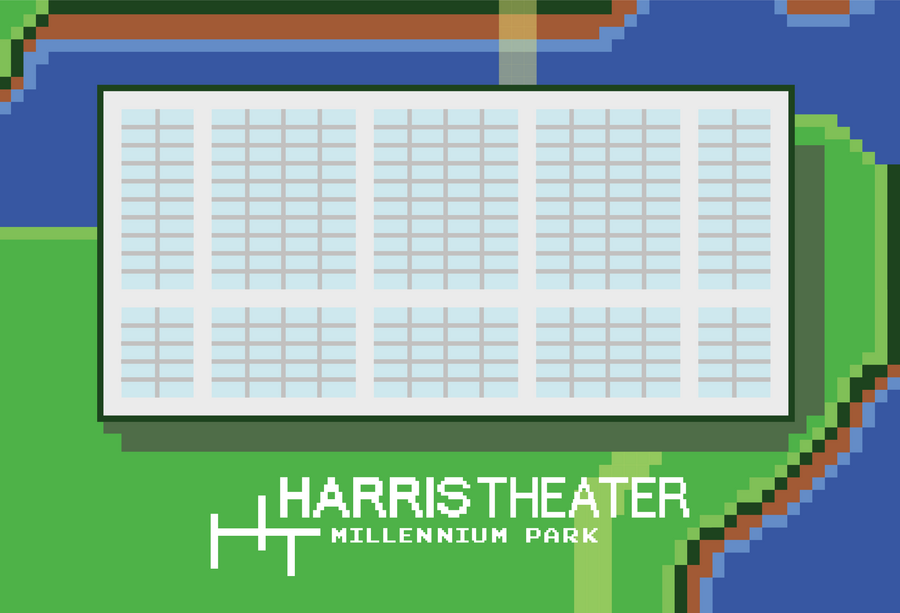
Around the same time, the Harris Theater, where Lucky Plush is a resident company, was looking to fund opportunities for resident companies to create new works in their venue, which had stood empty for months due to the pandemic. This was an important opportunity for Rhoads’ company, which hadn’t been in the studio together in months.
“It’s dance theatre,” Rhoads explained, “so we use dialogue, we sing, we partner, we touch. I couldn’t make sense of that with masks; it just was not something that we were doing at the time. But it occurred to me that it would be fun to do a piece that was really about the emptiness of the Harris Theater space at that moment.”
Rhoads called it both beautiful and sad to see a 1,500-seat Harris Theater that had sat empty for so long without people gathering. While audiences being physically in the space wasn’t an option yet, Rhoads saw Gather.Town as a way to bring her company’s work back to an active audience. So she applied to make a dance film as an opportunity for her dance theatre company to truly come together as a family again—perhaps even more appropriate, since their installation, Happy Returns, featured two young children born to two of the ensemble members during the pandemic. The presentation was filmed on the stark Harris Theater stage, to be presented through Gather.Town in a virtual version of the theatre.
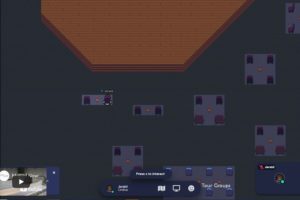
An important point about Gather.Town is its apparent customize-ability. Not only could Rhoads and company build out a virtual lobby for the Harris, complete with private seating areas, signage to encourage donations, and people standing around ready to guide you; they could also craft the seating in the theatre. If you’re attending a Gather.Town event with someone, you can sit in the same section of seating, again marked in clumps to indicate viewing groups, and watch the performance together with your webcams visible.
For The Map of Now, videos were streamed from YouTube but without the ability to rewind or see the time progress bar at the bottom. While you could pause, the simple act of putting an avatar in a theatre seat made it feel like you probably shouldn’t pause. But Rhoads told me that one of the reasons Gather.Town was an exciting opportunity was that it allowed spontaneous interactions as you might be coming from or leaving a performance, similar to what it would be like to be in a real space together.
But as someone who is invested in collaboration and connecting people, Rhoads started to think even more broadly, and see it The Map of Now as a chance to begin to bridge the divide between the arts on Chicago’s North Side and those on its South Side.
“People think, ‘Oh, Hyde Park, the South Side is so far,’” said Rhoads, who is also developing and overseeing the dance program at University of Chicago in Hyde Park. “Often audience members are very siloed, they don’t go past their comfort zones. Similarly, my students weren’t going to see things up north.”
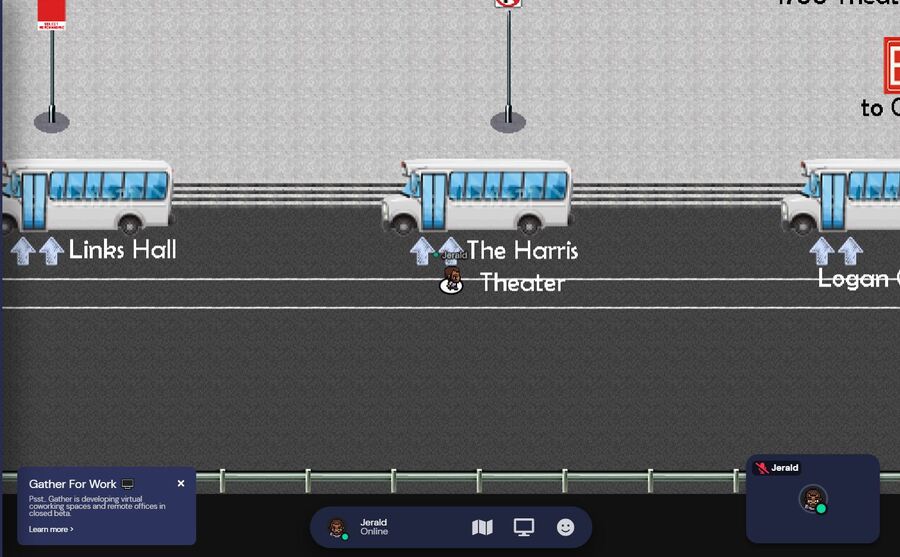
It’s a fair point. The Reva and Davis Logan Center for the Arts on UChicago’s campus can be up to an hour-and-a-half journey on public transportation from my North Side apartment. So The Map of Now provided a rare opportunity to see their venue without committing to three hours of commuting. It’s a good thing, too, since Sam Trump’s Spain vocal and trumpet performance, with a backdrop of floor-to-ceiling windows overlooking the South Side, was one of my favorites of the night.
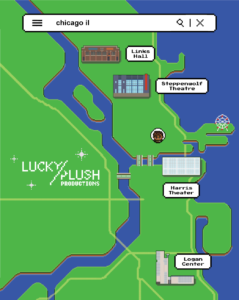
The Logan Center, as well as the other venues, had the opportunity to curate their own selections for The Map of Now. Rhoads told me that she reached out to the center to see if they were offering any similar opportunities to what the Harris was offering, giving artists a chance to film new work in these long-empty spaces. She was looking to partner with different venues, giving them the chance to uplift artists. Most venues featured artists’ work that was filmed in their space, though Steppenwolf’s selections featured short digital submissions from artists selected for a LookOut series program. Among their four submissions was Nire Nah’s The Wounded Wheel, a song accompanied by hand-drawn animation, and This Really Could Have Been in the Group Chat, a skit from the comedy collective BAPS Comedy, a group celebrating and empowering women of color.
The plan for the festival widened to include Links Hall, and as excitement around the project grew, so did the map itself. In addition to the venues that audiences could enter and games people could play, the map, designed with Dragon Productions Theatre Company under the design lead of Nathanael Card, also featured other Chicago landmarks: Lincoln Park Zoo, Navy Pier, the Museum of Science and Industry, and Garfield Park Conservatory. While these were mostly there to place you mentally within the real city of Chicago, other locales, like the National Museum of Mexican Art and the Neo-Futurists, had short promotional videos you could stop and watch as you walked through the virtual streets.
For those worried about potentially getting lost on the map, there were signposts to interact with, complete with friendly “you are here” stars, as well as the option to join guided tours. The latter would be a solid option for anyone who may be uncomfortable operating within this type of digital platform, even though the experience is very user-friendly.
As Rhoads and I were wrapping up our virtual conversation, she emphasized to me that there is plenty of room for this idea to grow—she considered this iteration relatively scaled down and manageable compared to a UChicago gathering space she was aware of that mapped the university’s entire campus. After attending, it’s easy to speculate about the potential of this platform for the arts. Whether it’s using something like Gather.Town to host an even larger city-wide arts festival, or to integrate a system like this with live performances and in-person audiences, allowing a select number of people to enter a virtual space and grab a seat for a live show.
“You can make a map as big as you want,” said Rhoads. “Especially for smaller venues, we could presumably be doing a live show in the future and have it live stream. The audiences that we’ve gained [during the pandemic] that are far away could come in through Gather.Town and sit in the virtual space and watch what other people are seeing live. Once we have this map, people can build on it. I hope to use it again.”
Jerald Raymond Pierce (he/him) is associate editor of American Theatre. jpierce@tcg.org


